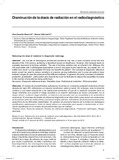Mostrar el registro sencillo del ítem
Disminución de la dosis de radiación en el radiodiagnóstico
| dc.rights.license | http://creativecommons.org/licenses/by-nc-sa/3.0/ve/ | |
| dc.contributor.author | Ramos Nuñez, Oswaldo | |
| dc.contributor.author | Villarreal, Manuel | |
| dc.date.accessioned | 2014-03-30T08:13:02Z | |
| dc.date.available | 2014-03-30T08:13:02Z | |
| dc.date.issued | 2013 | |
| dc.identifier.uri | http://www.saber.ula.ve/handle/123456789/38265 | |
| dc.description | Artículo publicado en: Revista Chilena de Radiología 2013; 19(1): 05-11. | es_VE |
| dc.description.abstract | El número de procedimientos radiológicos ha tenido un incremento acelerado durante la primera década del siglo XXI, obteniendo un impacto beneficioso sobre la salud. Sin embargo, este incremento conlleva a una mayor exposición a las radiaciones ionizantes. El uso de la radiación ionizante tiene un riesgo inherente, aun cuando el riesgo asociado a un examen radiológico es menor comparado con el riesgo natural, cualquier riesgo añadido, no importa cuán pequeño sea, es inaceptable si no se beneficia el paciente. El concepto de niveles de referencia diagnósticos se debe utilizar para reducir las variaciones en la práctica entre las instituciones y promover rangos óptimos, indicadores de dosis para los protocolos específcos de las diferentes modalidades. En general, los principios básicos de la protección radiológica (justifcación, optimización y límite de dosis) deben ser respetados para ayudar a contrarrestar el incremento injustifcado en el número de procedimientos que se realizan. | es_VE |
| dc.language.iso | es | es_VE |
| dc.publisher | Revista Chilena de Radiología | es_VE |
| dc.rights | info:eu-repo/semantics/openAccess | |
| dc.subject | Dosis de radiación | es_VE |
| dc.subject | Niveles de referencia diagnósticos | es_VE |
| dc.subject | Protección radiológica | es_VE |
| dc.subject | Riesgo asociado | es_VE |
| dc.title | Disminución de la dosis de radiación en el radiodiagnóstico | es_VE |
| dc.title.alternative | Reducing the dose of radiation in diagnostic radiology | es_VE |
| dc.type | info:eu-repo/semantics/article | |
| dc.description.abstract1 | The number of radiological procedures performed has had a rapid increase during the frst decade of the 21st century, achieving a benefcial impact on healthcare. However, this increase leads to a greater exposure to ionizing radiation. The use of ionizing radiation has an inherent risk. Although the risk associated with a radiological examination is minor compared to the natural risk, any added risk, no matter how small, is unacceptable if it does not beneft the patient. The concept of diagnostic reference levels should be used to reduce variations in practice among institutions and to promote optimal dose indicator ranges for specifc protocols of the different methods. In general, the basic principles of radiation protection (justifcation, optimization and dose limits) must be followed to reduce the unjustifed increase in the number of procedures being performed. | es_VE |
| dc.description.colacion | 05-11 | es_VE |
| dc.description.email | mavu@ula.ve | es_VE |
| dc.subject.facultad | Núcleo Rafael Rangel (NURR) | es_VE |
| dc.subject.keywords | Diagnostic reference levels | es_VE |
| dc.subject.keywords | Radiation dose | es_VE |
| dc.subject.keywords | Radiological protection | es_VE |
| dc.subject.keywords | Risk associated | es_VE |
| dc.subject.thematiccategory | Física | es_VE |
| dc.subject.thematiccategory | Química | es_VE |
| dc.subject.tipo | Artículos | es_VE |
| dc.type.media | Texto | es_VE |
Ficheros en el ítem
Este ítem aparece en la(s) siguiente(s) colección(ones)
-
Articulos, Pre-prints (Centro de Estudios de Semiconductores)
Articulos, Pre-prints del Centro de Estudios de Semiconductores -
Articulos, Pre-prints (Grupo de Investigación Científica y de la Enseñanza de la Física (GRINCEF))
Articulos, Pre-prints del Grupo de Investigación Científica y de la Enseñanza de la Física (GRINCEF) -
Articulos, Pre-prints (Núcleo Rafael Rangel (NURR))


